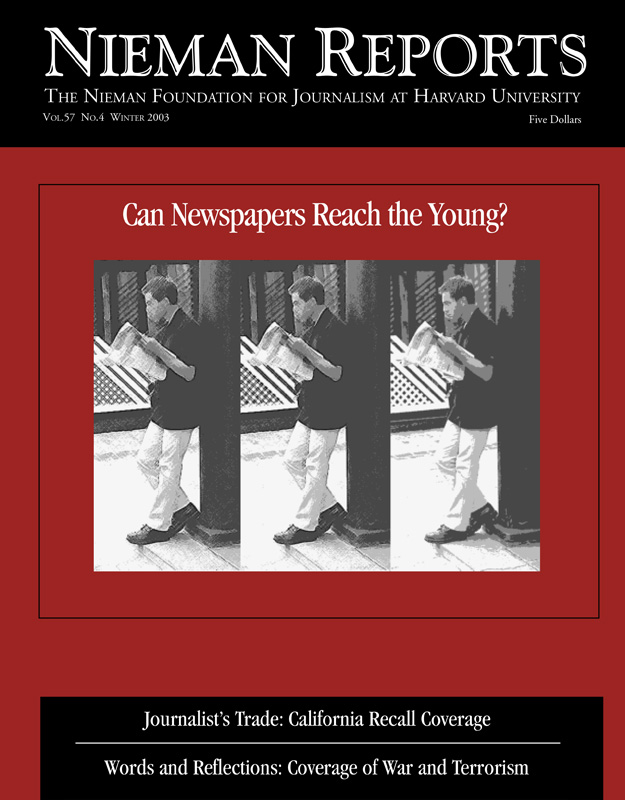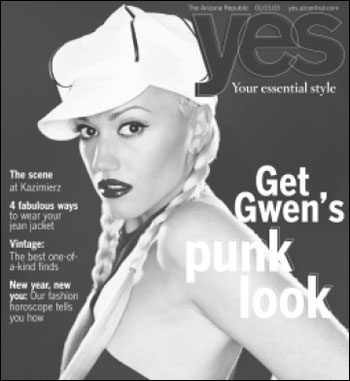
“I don’t have time to focus, I browse.” “I want to read about new things … hints on how to do things.”
“I read magazines, but usually I’m just looking at the pictures.”
“I’ll read a magazine if it has celebrities.”
Clearly, our traditional newspaper content was not going to get these young women in the door. However, the sheer size of the 18- to 34-year-old female age group in the Phoenix, Arizona market was huge—400,000 plus and growing—and meant we could not ignore them without putting at risk our paper’s future. Deciding what stories to cover and what information to convey to win them over as readers was only part of our challenge. Even if we created the right kind of publication, how could we get it into the hands of people who tell us they aren’t inclined to read a newspaper? To meet these challenges, we knew we’d have to move beyond traditional newspaper insertion and promotion, and to do that meant using every asset our company had.
What Young Women Want
Republic publisher Sue Clark-Johnson challenged us to come up with a breakthrough product that would truly resonate with these potential readers, a product that would, in her words, “move the needle.” One clue was that magazines like Lucky, In Style, and Real Simple were doing great with this age group. After learning what we could from their approaches, we decided to appeal to our region’s young women with a weekly local magazine-style tabloid with the credibility and flavor of these magazines.
To do this, we began talking to young women—at parties, at the gym, while they were dropping off kids at preschool. They told us they are interested in national and local news, but we knew the paper was working to present that news in useful, relevant and lively ways. That wasn’t enough. As we thought more about this challenge, what became clear was that something bold had to be done to attract this segment of the population to the paper. So we listened more and, over time, we realized they were telling us exactly what they want—something easy to read; something they could browse; something with photos and visuals to tell the story; something that is helpful and relevant; something that helps them look good, feel good, and stay on top of trends and fashions. Most importantly, they wanted something that’s worth their time to read. They wanted a payoff.
While these desires don’t necessarily add up to what we think of as serious journalism, women in this target audience were saying they would devote the time to reading if what they were reading was authoritative, credible and relevant. Some magazines do this well, but they also write about products from boutiques in Los Angeles, Chicago and New York. A focus on lifestyles and styles that aren’t relevant to young women who live in Phoenix doesn’t do us a lot of good; even the fashion seasons in these national magazines are wrong for us. Here we wear sandals in February and shorts into November. What this told us is there was a need for local fashion news.
We decided that our new publication, called Yes—Your Essential Style, would be all about our local style: our style of fashion, shopping, beauty, decorating, entertaining, relationships, fitness and parenting. It would also have a healthy dose of celebrities and the local young stylish scene. We would be what young women love most about national fashion magazines in one fast-paced, easy-to-read, local weekly edition.
The 10 Rules of Yes
We knew what we wanted; now we had to produce it. We gathered young women from around the newsroom and asked them to envision the product. In true magazine style, they came up with 10 things a reader must know about Yes:
- Reading it is like talking to your best friend. Yes must act and feel like someone who shares your secrets, revels in your finds, and shares your passions.
- Everything in it will be quick and to the point. No story would be more than 10 inches long and no story would jump. This product would be driven by quick bits of information and strong visuals.
- Yes doesn’t talk to young women but with them. Often we write about Gen-X and Y like they are something different than “us.” This section would be written from the perspective of a young woman. Headlines would be full of “you” and “how,” “our” and “we”: “Five sandals you must have for spring.” “Throw a shower for under $75.”
- Every story must have a payoff. Our time is precious, we demand a payoff such as: learning about a new product or trend (“the one skirt you must have for fall”); picking up a new skill (“how to make handmade paper”); getting useful, real-life information (“five questions you must ask at your next annual exam”); getting in on a secret (“how the experts throw dinner parties”), or getting research done for us (“10 romantic day trips”).
- It will offer instant gratification. Yes wouldn’t just tell you that coral is the new color for jewelry. It would show you three cool coral pieces we found locally, tell you exactly where we got them, and provide Web links, if available. On our Web site, hot links would take you right to the product you were reading about.
- It can’t contain “old” news. Just like your best friend, we must be the first one to tell you something. News is never so exciting the second or third time you hear it. So we’d be quick. Real quick. If we printed something out of style, out of fashion or out of touch, we’d do more than print a bad story. We’d weaken the credibility of the entire section. And credibility is everything.
- It will be local. We’d run celebrity pictures, but then we’d tell you where you could get their look locally. We would take fashions from New York and show you how to wear them in Phoenix.
- We can’t be snarky. We would be hip, but not exclusive. We would advise, not lecture.
- We will be trustworthy. If we said something would be all over the clubs, it had to be. When we said pink was the new white, readers had to trust us. To help us in this mission, we would form a “Style Council.” This group would include “official” people, like department store buyers. But it also would include “real” people, like the woman at the Nordstrom’s cosmetic counter who picks your perfect lipstick on the first try.
- Advertising is content. We know young readers buy magazines as much for the advertising as the editorial. We recognized that the ads in this section must match the tone of the stories. In addition to the right ads, sales reps must get the right advertisers.


Yes Is Launched
Yes launched on November 15, 2002. Readers can get the magazine either in the newspaper, at one of 1,200 free rack locations around the city, or online at yes.azcentral.com. Twice a week, we send Yes e-mail newsletters to online subscribers, and our partner NBC television station, KPNX-Channel 12, produces weekly Yes segments for its morning news show. In April, we also broadcast a prime-time television special, Yes Next, that ran after “Friends” and before “Will & Grace.”
What has been the reaction? We’re bolstered by what we’re hearing from young women now, which is much different than we heard just over a year ago:
- “I love this new section of the newspaper. I look forward to reading it each week.”
- “I am a self-professed magazine junkie and fashion-aholic … and I really enjoy your publication. The identification of the challenge of making the fashion of L.A. and N.Y. available and accessible to Arizona and even So Cal fashionistas was dead-on.”
- “I love reading Yes. I never looked in the paper until my mom showed me the fashion section. Now I actually look forward to seeing The Republic on Fridays.”
And our quantitative measures are showing positive responses, too. Week after week, virtually all of our 1,200 free rack locations are emptied of copies. Our Web site has had tremendous traffic, and each week Yes slideshows draw more than 200,000 page views. It takes some time to grow an audience in a market of this size. But research tells us that young women who see Yes like it and that they say they’d buy the paper just to get it. And women of all ages have told us how much they like this new approach, even though it’s clearly targeted at younger readers.
Nearly a year into Yes, this magazine-style tabloid is still evolving, and so are we. It hasn’t been all easy going. To make this work, a newspaper staff had to learn how to do magazine-style writing and design. And some staffers questioned whether this type of product belonged in the newspaper at all. But as we’ve grown more accustomed to our mission, lessons from Yes have begun to be applied to other parts of the newspaper. New education pages are consumer driven with narrowly focused stories and lists and charts that provide easily accessible and helpful information. A new Sports page called Quick Hits—with an ESPN The Magazine kind of attitude—is layered with bits of news and talk from and about sports personalities.
Targeting young readers isn’t a onetime push. As the current group ages and the next generation emerges, their needs and wants will change, as well. The only way to stay relevant is to change with them. This is exhausting for some, invigorating for others. For me, it’s a great challenge—one we all need to find ways to meet.
Nicole Carroll is deputy managing editor/features of The Arizona Republic, which won first place in Gannett’s 25 to 34 Review for outstanding achievement in tareting younger readers. Carroll was the key editor in the Yes—Your Essential Style section’s development and continues to supervise the publication.


